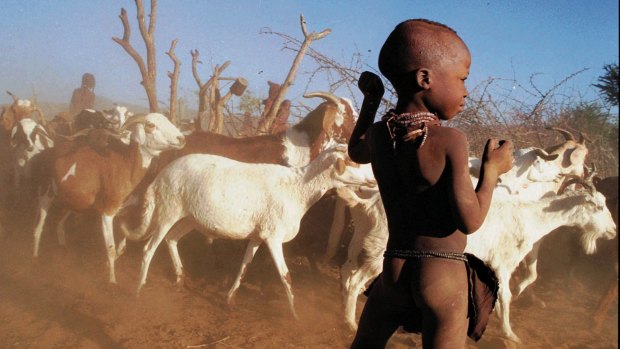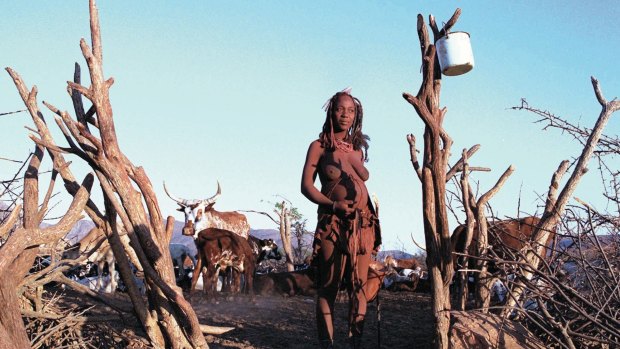This was published 4 years ago
Himba, Namibia: The forgotten tribe who survive in one of the world's wildest corners
By Nina Karnikowski

Eitha, a little Himba boy stands outside the ekraal, his homestead, while goats are being chased out to graze for the day.Credit: AAP
We arrive in the Himba village in the late morning. Seven tribeswomen sit in the dappled shade of a mopane tree, laughing and gossiping and rubbing otijze paste - a mixture of red ochre, butter and fat - into their skin, giving it its distinctive red sheen and protecting them against the sun. The women are bare-chested, clad only in animal skin skirts and elaborate jewellery made of metal, shells and leather. Their plaited hair is covered in thick ochre paste with oryx tail tufts attached to the end. Beside them, around two dozen of their children play; some roll a rusty steel drum along the ground, while others dash in and out of the domed, dung-covered huts scattered around us. It is a scene from another time, another world.
It took hours of driving along bumpy, dusty roads this morning to reach this other world, set in one of the most remote and wild areas of Namibia, the Kunene region in the country's northwest corner. Watching the tight-knit tribe, it isn't difficult to understand how they have survived in this dry, unforgiving landscape since the 16th century. They are strong, resourceful people, semi-nomadic pastoralists who live off the land and the cattle and goats they herd. Yet while there are estimated to be about 50,000 Himba living in Namibia, my local guide Nestor Nghuunduka tells me that very few of them still live in this traditional way, with a steady stream leaving village life for the fast-paced modern world. So steady, in fact, that Nghuunduka predicts that if I return in 20 years, I may not find any Himba still living like this.
Knowing I may never again get the chance, I start asking the women questions. How do they bathe out here, so far from any water source? With Nghuunduka translating, the women tell me they never wash, but instead take smoke baths every morning. They show me how they squat over coals covered with herbs to cleanse and perfume their bodies, before applying more otijze paste to further clean and soften their skin. I ask three of the young women their ages - none of them knows exactly, and instead they tell me the number of children they have.

The Himba are so pastoral, they don't know their ages or how many they number and scratch out a resourceful existence in a cruelly beautiful pastel landscape of sand, rock and sky. Credit: AAP
When they discover that I'm 35, the age of a grandmother here, and that I am childless, they are aghast. Why don't I have any children? I'm too old! What is wrong with my husband? I should get another one if he hasn't given me a baby! I can't help but laugh, but Nghuunduka tells me their questions are serious. Himba women, he says, usually marry as soon as puberty starts and have as many babies as possible. They also practice polygamy, with both men and women being allowed to have multiple partners.
One of the women soon shows me into her tiny, windowless mud hut, where she and her husband and their four children sleep each night on raw goatskins. My first reaction is one of sympathy; this hut is the size of my laundry room back home. But then we head back outside and I see the rest of the women still chatting and laughing and playing with their children, with such a level of relaxed intimacy and joyfulness that I have rarely witnessed between women back home, that I ask myself: who should really be pitying who? By the time I climb into our Jeep and wave goodbye to the women, I still don't have an answer. Perhaps I never will. Perhaps just having more questions, and a slightly shifted perspective on what it might mean to live a good life, is enough.
TRIP NOTES
FLY
South African Airways flies from Perth to Johannesburg daily (11 hours), then connects to a two-hour flight to Windhoek, Namibia, using codeshare partner Virgin Australia. See flysaa.com
TOUR
Bench Africa's 11-day self-drive safari itinerary includes a visit to the Himba tribe, as well as to other popular Namibian sites including Sossusvlei, Damaraland and Etosha National Park. From $4680 per person; see benchafrica.com
MORE
Nina Karnikowski was a guest of Bench Africa
Sign up for the Traveller Deals newsletter
Get exclusive travel deals delivered straight to your inbox. Sign up now.